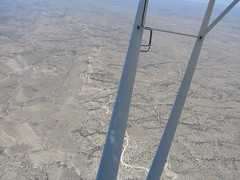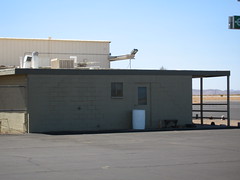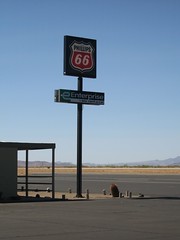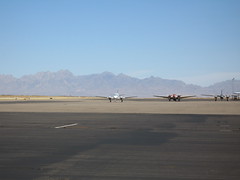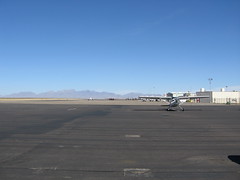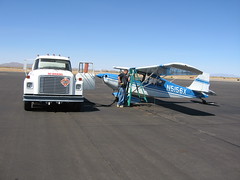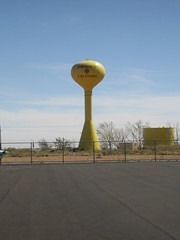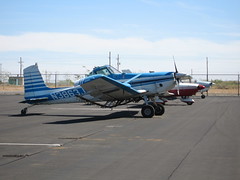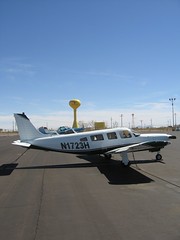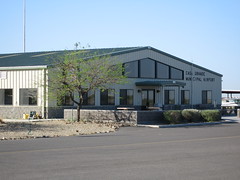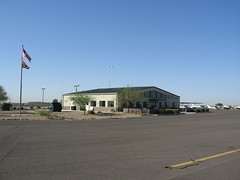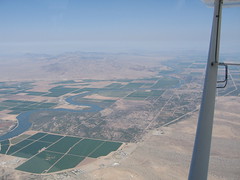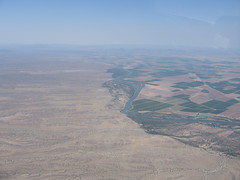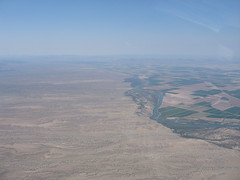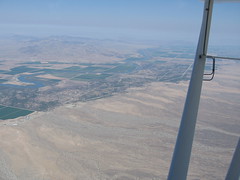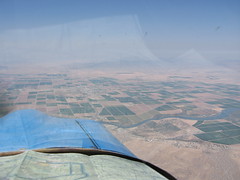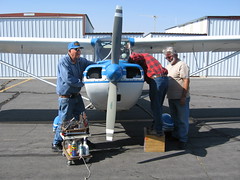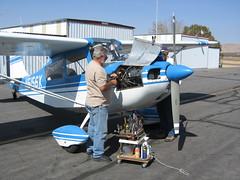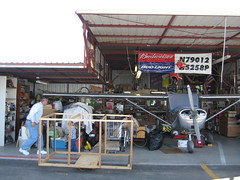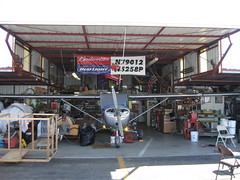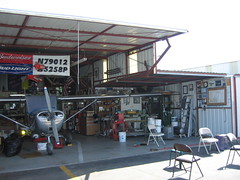One week ago I headed to Cleveland, Texas with Jim (my flight instructor). Our mission, as previously noted was to fly Citabria N5156X back to California over the course of 3 days and meet up with Lance (my partner in the plane) in central California. From there he'd fly it the rest of the way back to San Jose.
This is my trip report, which includes notes about the flying, where we stopped for fuel, stayed at night, ate dinner, and the many lessons learned along the way.
Oh. It's kind of long.
Friday: Cleveland, Texas to San Angelo, Texas (3.6 hours)
We arrived at the Cleveland airport around 1:30pm and spent the next few hours looking over the plane, meeting a bunch of the locals, and cramming all our stuff into the baggage area. While the Citabria has a baggage compartment limit of 100 pounds, it's surprisingly spacious. We had no trouble getting everything in. And I estimate we had at least 10 pounds of wiggle room as far as the weight is concerned.
With everything ready to go, we went to the airport office to plot out our first day of flying and file a flight plan. We figured we'd be in the air by 4pm and be able to get in 3-4 hours of flying. So we planned to stop for fuel in Llano and then, depending how much progress we were making, push on in the direction of San Angelo.
To Llano...
With that, we headed back to the plane where I got a 2 minute tour of the Lowrance AirMap 100 GPS, started the engine, and then taxied to the run-up area. Before long, we were climbing through 500 feet and I turned us on a westbound heading. I dialed in the first VOR and punched it up on the GPS as well.
After about 10 minutes of flying over terrain I'd never flown before in a plane that I'd met only a few weeks before, it really hit me: holy crap, we're actually doing this! It was finally time to put all that book learning to work and figure out how to get the two of us and my little airplane to our first fuel stop.
Before too long, I was picking up the first VOR and got to try my hand at chasing the CDI in an attempt to stay on course. Luckily, it wasn't hard at all. I was also becoming more comfortable with the plane's flying characteristics: the way the throttle slips at certain RPMs, the fact that it flies quite nicely straight and level when trimmed correctly, and so on.
As we passed over Texas A&M University I remembered that I had my camera on board and shot a few pictures. Visibility was good and the headwinds weren't bad, so we made good time to Llano.
At our first fuel stop we checked the oil level, measured fuel in the tanks, and gassed up. The gas was self-serve and, at $3.10 per gallon, the cheapest we'd see on the whole trip. I remarked that it should be cheaper in Texas. They make gas there! (We flew over many an oil pump on the trip.)
After fueling up, we took off for San Angleo. The flight was uneventful and we passed the time by watching out the landscape was gradually beginning to change from flat and green to slightly higher and browner. We encountered out first ridges on this leg of the flight.
As the sun got lower and lower on the horizon, we worked our way closer to San Angleo. Eventually we were within radio range and I dialed up the ATIS. We were surprised to learn that San Angelo had an approach control frequency in addition to the tower frequency. We started to wonder how much traffic the little airport got.
I called up San Angelo Approach to let them know who I was, where I was, and what I intended to do (land there). They gave me a transponder code and handed me off to the tower about 8 miles out. I called up the tower and was immediately cleared to land. Heh. They weren't terribly busy.
We landed just before sunset and I turned off the runway, wondering where to find fuel. Just as I was expecting the tower to direct me to the ground frequency, he asked me if I was familiar with the airport. I admitted that I wasn't and asked him where we could get fuel and tie down for the night.
The tower nicely directed us to Ranger Aviation. We were met at our tie-down spot by a line guy who asked us if we needed fuel and a place to stay. Before long, he had supplied us with tie-down ropes, gassed up the plane, and directed us to their nicely equipped office. Inside the person at the desk quickly arranged for rooms at the local Comfort Inn and a shuttle to come pick us up.
We spent the 30 minutes until the shuttle arrived checking out their facilities. They had an excellent pilot lounge that featured several computers with Internet access and a dedicated weather terminal. They also had a good supply of drinks and some freshly made cookies for the taking. It's no wonder I was paying an extra dollar per gallon more than at our last stop!
The shuttle arrived and took us to the Comfort Inn. On the way, we arranged for the driver to bring us back to the airport at 8am the next morning. Saturday was to be our longest day of flying, so we wanted to start early.
Once we were checked in, it was a quick walk to the attached Mexican restaurant for some chips, salsa, and fajitas. We planned to meet the next morning at 6am for breakfast (free!) and a flight planning session.
Saturday: San Angelo to Casa Grande, Arizona (10 hours)
As planned, we met at 6am to sample the coffee, yogurt, oatmeal, bananas, and other breakfast goodies. I brought along a healthy selection of maps to plot the day's course while Jim updated our log books.
Before too long, I had a route figured out and measured. I then made a list of all the navigational information we would need (VOR frequencies, identifiers, distances, compass headings, etc.).
We checked out, met the shuttle, and were back at Ranger Aviation by 8:20am. I spread out my charts, drew course lines on the sectionals (I did most of the planning on the World Aeronautical Charts (WACs) since we were flying long distances), filled out the flight plan, and called for a briefing.
The good news was that the weather was going to be clear all the way into Arizona. The bad news was that we'd be battling nearly direct headwinds in the range of 20-30 knots all the way across West Texas, Southern New Mexico, and into Arizona. That was gonna slow us down for sure.
To Pecos, Texas...
Our first leg was to Pecos, Texas. Robin Reid had suggested we stop there for lunch, so we did just that. It took a while to get there battling the headwinds too.
We started off cruising at 4,500 feet but were getting knocked around by the late morning thermals. So we climbed to 6,500 in an attempt to avoid the thermals and increase our ground speed. We managed to do neither, so I pushed us up to 8,500.
At that altitude the thermals were minimal but there was still some turbulence. However, our ground speed was no worse than at 6,500 so it was a worthwhile tradeoff. We'd burn less fuel at the higher altitude.
It was around this time that I got my first real experience leaning the fuel mixture out to compensate for the lower density of the air at altitude.
We eventually reached Pecos and found the airport without any trouble. Dialing up the AWOS, I learned that the winds were really blowing on the ground. If I recall, we had at least a 30 degree left crosswind that was gusting between 12 and 25 knots. It had been a while since I'd practiced crosswind landings.
With some help from Jim, I got the plane on the ground and got to experience taxing in high-wind conditions. We headed toward what I suspected was the fuel island only to find a lone person out there waving us in. A teenager pointed us to a parking spot where we'd have the nose into the wind at Pecos Air Center.
We tied down the ship while he brought the fuel truck over to gas up the plane and clean off the windshield (woohoo!). He directed us inside where we could get out of the wind, use the restroom, and eat.
After he came back in to meet us, we learned that they had a refrigerator full of food and drinks that was all on the house. While we drank cold water and munched on the chips and salsa, he microwaved us a few burritos that were really nothing more than beef wraps.
We chatted a bit about the airport and all the military pictures on the walls. They've apparently got a refueling contract with the government, so they get a decent stream of visitors.
After a final bathroom break, a bit of time looking at the map on the wall, and a few cookies for desert, we signed their guest book and headed out to he plane.
Again, I got to taxi in high wind conditions and make a fun crosswind takeoff. But we were quickly back on course and cursing the headwind once again.
To Las Cruces, New Mexico... (not Deming)
We hoped to make it to Deming, but the headwinds made our fuel situation less than comfortable. So I suggested that we divert a little northward to land at Las Cruces, Mew Mexico. They had a good sized airport and fuel available.
Along the flight there, we encountered a bit of wave lift (and sink) off the mountain ridges, so I got the ideal to dial up 123.3 (the glider air-to-air frequency) on the radio and see if anyone was flying. Sure enough, I heard several folks flying out of Marfa, Texas in a decent wave. I chatted with an ASW-27B driver for a bit.
Approaching Las Cruces, I spotted at least one place to tie-down and fuel up. So upon landing on their big runway (directly into the wind, no less!), I headed in that direction. But we noticed something odd. There were two competing FBOs who wanted me to drop by to fill the Citabria's tanks.
I had to decide if I was going to turn left or right. The guy on the left was sitting in a golf cart and half-heartedly waving a flag. Oh the other hand, the guy on the right had walked out on his own and was waving a pair of flags quite vigorously.
I turned right. I didn't want to reward the lazy guy.
We got gassed up and headed into the FBO (Southwest Aviation). We looked at the maps a little bit, I revised our course, marked up the WAC and sectional, and filled out a new flight plan. I then called up the local flight service station (FSS) to get an updated weather briefing and to file the plan.
After a chat with a very talkative briefer who actually knew what a Citabria was ("it's a cute little airplane!"), we hopped back in the plane and pressed on.
To Casa Grande, Arizona...
As expected, the headwinds were still there. So it was a slow ride into Arizona and over the high terrain we needed to cross in order to reach Casa Grande (just south of Phoenix). The terrain was amazing. Lots of mountains, ridges, and valleys. I'd love to see it from the ground someday.
This was the one leg of the trip on which things got a bit "interesting." The briefer had told me about some haze and dust in the air near the Phoenix area. And we were flying into the sun. So as the sun got lower on the horizon, visibility decreased quite a bit. Worse yet, we had to cross some very unfriendly terrain. So we flew high and hoped we wouldn't need to find a place to land.
Luckily, the winds were shifting and we picked up a tailwind. Instead of crawling along with an 80 knot ground speed, we were pushing 100 knots for the fist time in quite a while.
We landed at the almost deserted Casa Grande Municipal Airport just before sunset, fueled up the plane, tied it down, and called for a cab to take us to the local Comfort Inn (official sponsors of our trip, apparently).
After checking in, we walked the ten minutes necessary to hit the local Cracker Barrel. I hadn't eaten at one in ages and wasn't disappointed. I got a sampler meal that included a bit of the meatloaf the staff was encouraging us to order.
It was some damned good meatloaf!
We headed back to the motel and decided to meet at 7am to eat breakfast. We had already arranged for an 8am pickup. And the time zone changes meant it was still a bit early, so I was going to do all the flight planning at night and then run it by Jim over breakfast.
Sunday: Casa Grande, Arizona to Apple Valley, California (3.4 hours)
The cab driver dropped us off at the plane (literally, right next to the plane!) around 8:25am and we loaded all our gear back into the back. I went inside to get a briefing and file our flight plan while Jim performed a pre-flight inspection.
We were in the air by 9:15am, activated our flight plan, and headed toward California. Today was set to be a fairly easy day of flying with just two stops. First, we planned to stop in Twentynine Palms, California to gas up and check weather. Then we'd head north into central California to meet Lance and his wife in Visalia.
To Apple Valley...
The briefer had been right about the winds. We had a slight wind from the south, but basically no headwind. So we cruised along with a 100 knot ground speed and made very good time.
Before we knew it, we crossed the Arizona/California border (by flying over the Colorado River) and just kept on going. As we approached Twentynine Palms, it was clear that we didn't need to stop yet. So I pulled out the map and suggested that we fly another 45 minutes or so to Apple Valley.
We landed in Apple Valley after spotting the fuel islands from the air and headed over the gas up. Being Easter Sunday, the airport was understandable quiet. The only other folks flying were in a Pitts and an Edge, practicing aerobatics routines.
After gassing up, I called Lance to let him know our status and then we headed over to the little terminal to discover that the café was open and serving food! On Easter Sunday! So we stopped for lunch before continuing on our flight.
Engine Troubles!
After lunch, we got back in the plane and headed out. Sort of.
During the run-up check, I was a little surprised when I turned off the let magneto and there was no RPM drop registered. None at all. Every other time, I'd seen roughly a 100 RPM drop.
I turned it back on and then turn off the right mag. The engine started to die, so I quickly switched it back on and got a bad feeling in my stomach. I did the test two more times so as to make sure we were both convinced that there was a serious magneto problem--not just a fouled plug or two.
Grr.
We taxied back to the tie-downs, got out, and attempted to figure out what was wrong. After a bit of poking around, we discovered the problem. The left mag was loose! After more poking around, the problem was clear. It was missing a few of the screws that hold the back piece of the mag in place.
(Amusingly, the only redundancy in most single engine piston driven aircraft is the fact that they have two mags rather than one. The Wikipedia page on Magneto explains what one is.)
Doh!
This was a very bad sign. Our odds of finding a mechanic available on Easter Sunday on a small airfield were basically zero, so we started making phone calls. Jim called a Citabria mechanic back in San Jose for advice, while I called Lance to see if he'd be willing to drive the 2-3 hours necessary to fetch us and then all the way back to San Jose (another 7 hours).
It was clear that the plane would not be going to San Jose on that Sunday.
Once the calls were made, we had nothing to do. So I suggested we walk the airport to look for a mechanic. Who knows, there might just be one wandering around. Maybe one of the aerobatic pilots was also an A&P (airframe and power plant mechanic).
To make an already long story a bit shorter, we managed to stumble across a group of guys who were, for lack of a better term, hanging out in front of their hangars. Despite my utter disbelief, the conversation started like this:
Me: How you guys doing?
Them: Great! How are you?
Me: Could be better. I don't suppose any of you are aircraft mechanics.
One of them: Ray (motioning into the hangar) is a mechanic. What do ya need?
Before long, they had practically adopted us as family. They asked us to bring the plane over, so we did. We opened the engine cowling, and they literally dove into the task of finding screws to re-attach the magneto. Ray and his merry men were quite impressive.
While that was going on, they got us eating Jello shots and then gave us a tour of the garden they've been building behind the hangars. (Yes, these guys practically live at the airport.)
Within an hour or so, they had the magneto re-attached and asked me to test the engine. I was more than happy to fire it up again. But hope was dashed when the mag failed to fire during my test.
While we were off looking at their gardens again, one of the guys says "Patrick is here!"
"Who is Patrick," I ask.
"He's the mechanic from Midfield Aviation."
"Holy crap!" I thought. We've got the best luck. The mechanic was on the field on Easter Sunday!
He wanted to check the engine himself, so he fired it up and listened to what was going on. Then he used Ray's tools to begin removing the oil cooler so he could get at the faulty mag. Before long, he'd diagnosed it.
The mag was dead. Very dead. He read off the part number so that I could order a new (well, refurbished) one (Bendix 10-51360-37) and then put the oil cooler down so we could taxi the plane over to his tie-down area.
It's a good thing he didn't fix on the spot because we couldn't have legally flown it home anyway. I can just imagine what I would have told Lance when he showed up...
"Hey, the plane is fixed! But we can't fly it back because we've been eating Vodka in the form of Jello, so this isn't gonna work today..."
He did show up a couple hours later. We quickly packed the gear into the car and began the long trek home. I arrived at home (after dropping Jim off) around 2am.
As of now, Patrick has the new mag and will hopefully have the plane running so we can bring it back this weekend.
Observations and Lessons Learned
Here are a few random observations and lessons learned during the three days of flying and not flying I did.
- I put 17 hours on the plane in 3 days. That gave me a pretty good feel for how it flies and really helped to build my cross-country flying confidence. I'm ready for my solo cross-country flights now.
- The briefers at the flight service stations all have different codes in their databases for a Citabria. One wanted AC7, another needed CH7, and one needed CH7A. How confusing!
- VOR navigation isn't hard at all. In fact, it makes a ton of sense when you're actually doing it.
- The same is true for the flight planning that happens on the ground.
- Our fuel burn got better over time, mostly as I got better about leaning it. Near the end, I think we were in the 7.1 or 7.2 gallons per hour range.
- Nearly every airport we visited hand abundant tie-down space on a very large ramp, and it was almost always 90% empty. I get the feeling there are a lot of over-built airports around.
- Wind can be a real bitch--both in the air and on the ground.
- Playing "spot the VOR" makes long flights a little more fun. I managed to find all but one of them.
- You can meet some of the nicest, most helpful and amusing folks at small airports. Even on Easter Sunday!
What an adventure.
Posted by jzawodn at April 21, 2006 05:36 AM | edit
Thanks for the story, Jeremy. Makes me somewhat sad I've let my pilot's license lapse, doing some cross country trips would be a lot of fun!
Sean
Good story... Too bad you didn't catch the edge of a weather system, which can give you tailwinds going west in the winter sometimes. Bringing a Mooney 231 home from Cleveland (Ohio), a friend and I managed to fly from Denver to San Jose non-stop -- over 1,000 NM without refueling (or a restroom!).
Flying into haze around sunrise and sunset -- that was a reminder. It can really fool you. It may be technically VFR but you might as well be in IMC for all you can see. This is very, very common flying into Los Angeles over the Golden State Freeway in the morning. It's quite tempting to go IFR (I Fly Roads), but it's a sucker's bet.
Congratulations on your cross-country trip. Sounds about right; lots of boring scenery, headwinds, and a malfunction that grounds you on the way. And yet somehow it was all fun and you can't wait to do it again!
Nice trip. I'm looking forward to seeing your Citabria. The official FAA type designator for a 7KCAB is "CH7B". Check out http://www.faa.gov/ATpubs/ATC/Appendices/atcapda.html and look under "Bellanca".
Cost to buy? No, I didn't mention that. But it's readily available to anyone with enough interest, an internet connection, and 45 seconds of free time.
Cost to own? That's trickier. I think I have a good model worked out for that, but we'll see. Perhaps I should write that up after we've had it for a year or so.
Ours had a ground-up rebuild in 1987 as the result of a landing accident in 1985, so much of it is newer than that. The prop is new (less than 100 hours) and the engine had a major overhaul less than 100 hours ago too.
Of course, it's got bad mag, so you win some and lose some, eh?
Thanks for this post! Makes me want to get back in the air and finish my pilots license training! I'd love to see post about how much a plane costs to own as well!
Nice post. I'm glad your trip went well. I was a pilot briefer for 5.7 years. I'm a controller at ABE. I love reading stories like this. I want to get back in the air, too. I have a plan to get airborne in 3 years. I've flown about 150 hours over NY, PA, and OH.
I was a controller at Livermore (LVK) tower from 1992-1998. I worked with three or four of the controllers who now work in SJC tower, a few at OAK tower, and a couple at NORCAL approach. You've probably talked with them. I flew a few times in the SF Bay area, out of LVK. I flew in a C177, C172, RV4, CH7B, Cub, and Pitts, each with different pilots. I'm 6' 1" and found the Citabria to be a little cramped for my height. It was hard to get full stick movement. Anyway, I love pilot stories and pictures.
Thanks.
Great story. I didn't realize you were in to aviation. I'm currently nose-in-the-books doing a home based ground school. Hope to get started in CFI training before the end of the year.
Loved it all! Gives me a great perspective of the Cross Country expierience. I have started flight lessons here in North Carolina and have a ways to go before I do a cross country, but I look foward it to it!
I just read your article on your cross country flight. It sounds like you had a great time. What would a trip be without some sort of a malfunction, well it's a good thing your mag problem happen on the ground. That's what I like about GA, landing at small airports on the way to your destination and talking to the locals ( minus the mag problems). My FBO is in Riverside Municipal AP in CA and we also have a few small airports of our own near by which are fun to visit, plus they have great food.
I plan on doing more flying like I mentioned in my last post, not only for pleasure but also for business too. It's like having the best of both worlds. By the way Jeremy, you are the only pilot I've every seen with a blue AOPA cap just like the one I've been wearing for the pass 22 years. For a moment there I though I was looking at myself. :-) I was starting to wounder if any one else wore them. By the way if I were you I'd keep that Citbria, It's a cool looking plane.
Happy Flying
Awesome story. I enjoyed it! I learned to fly at Midfield Aviation in Apple Valley and still rent there. I have known Patrick for years. He's an awesome mechanic and a good hearted business man. Almost everyone at APV lives in their hanger. This is an awesome airport and love that it's my home airport! :)








